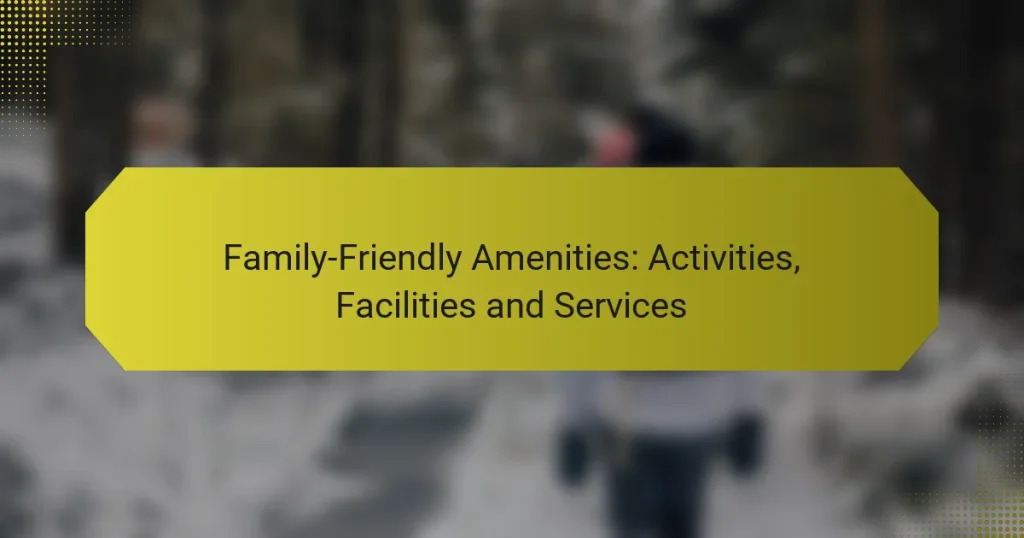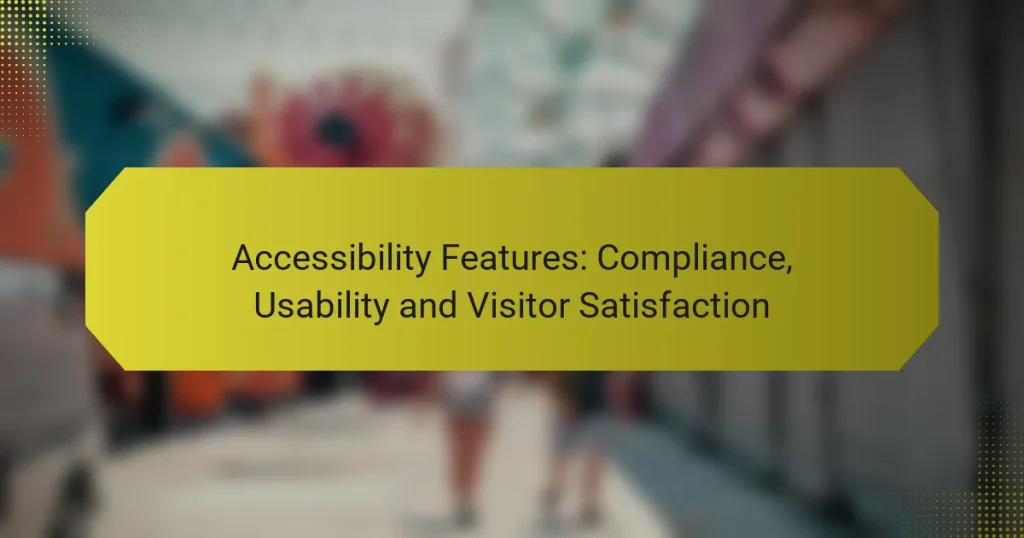Science and technology museums in the US are equipped with a variety of visitor amenities that enhance the overall experience. From guided tours and interactive exhibits to cafeteria services and gift shops, these features cater to guests of all ages, making learning both enjoyable and memorable.
Visitor Amenities: Impact on Ratings and Overall Experience
Visitor Amenities: Comfort, Accessibility, Family-Friendliness
Visitor Comfort: Enhancements, Services and Amenities
Family-Friendly Amenities: Activities, Facilities and Services
Food Options: Variety, Quality and Dietary Considerations
Accessibility Features: Compliance, Usability and Visitor Satisfaction
What visitor amenities are available at science and technology museums in the US?
Science and technology museums in the US offer a range of visitor amenities designed to enhance the experience. These amenities include guided tours, interactive exhibits, cafeteria services, gift shops, and accessibility features, all aimed at making visits enjoyable and informative.
Guided tours
Guided tours provide visitors with in-depth insights into exhibits and collections. Typically led by knowledgeable staff or volunteers, these tours can last anywhere from 30 minutes to several hours, depending on the museum’s size and the specific tour. It’s advisable to check the museum’s schedule in advance, as some tours may require reservations.
Interactive exhibits
Interactive exhibits engage visitors through hands-on experiences, allowing them to explore scientific concepts in an enjoyable way. Many museums feature activities like simulations, touchscreens, and experiments that cater to all age groups. These exhibits not only entertain but also educate, making complex topics more accessible.
Cafeteria services
Cafeteria services at science and technology museums typically offer a variety of meal options, including healthy choices and kid-friendly fare. Visitors can expect to find sandwiches, salads, and snacks, with prices generally ranging from $5 to $15 per person. Some museums may allow outside food, but it’s best to check their policies beforehand.
Gift shops
Gift shops in science and technology museums provide a selection of educational toys, books, and souvenirs related to the exhibits. Prices can vary widely, with items ranging from a few dollars for small trinkets to over $50 for specialized educational kits. Shopping at the museum supports its programs and initiatives, making it a worthwhile stop.
Accessibility features
Most science and technology museums in the US are committed to accessibility, offering features such as wheelchair ramps, elevators, and accessible restrooms. Many also provide assistive listening devices and guided tours tailored for visitors with disabilities. It’s recommended to contact the museum in advance to inquire about specific accommodations and services available during your visit.
How do science and technology museum tours enhance visitor experience?
Science and technology museum tours significantly enhance visitor experience by providing interactive and informative opportunities that engage guests of all ages. These tours often combine educational content with hands-on experiences, making learning enjoyable and memorable.
Educational programs
Educational programs at science and technology museums are designed to deepen understanding of scientific concepts and technological advancements. These programs may include workshops, lectures, and guided tours that cater to various age groups and knowledge levels.
Many museums offer tailored educational experiences for schools, which can include curriculum-based activities that align with local educational standards. This approach not only enriches the learning experience but also fosters a connection between students and the subject matter.
Hands-on activities
Hands-on activities are a hallmark of science and technology museum tours, allowing visitors to actively engage with exhibits. These activities can range from interactive displays to experiments that encourage exploration and creativity.
For example, visitors might participate in building simple machines, conducting chemistry experiments, or using virtual reality to explore scientific phenomena. Such experiences are particularly effective in making complex concepts more accessible and enjoyable.
Expert-led discussions
Expert-led discussions provide visitors with the opportunity to engage directly with knowledgeable professionals in the field. These discussions often cover current trends, breakthroughs, and the implications of technology in everyday life.
Participating in these discussions can greatly enhance a visitor’s understanding and appreciation of science and technology. Museums may schedule these sessions regularly, allowing guests to ask questions and gain insights from experts, which can lead to a deeper interest in the subject matter.
What are the pricing options for science and technology museum tours?
Science and technology museum tours typically offer various pricing options to accommodate different visitor needs. These options may include general admission fees, group discounts, and membership benefits that can enhance the overall experience.
General admission fees
General admission fees for science and technology museums usually range from around $10 to $30 per adult, with discounts for children and seniors. Some museums may offer free admission on specific days or during certain hours, so it’s wise to check the museum’s website for current pricing and promotions.
Additionally, many museums provide family packages that can offer better value for those visiting with multiple children. Always verify if there are any special exhibitions that might require an additional fee.
Group discounts
Group discounts are commonly available for parties of ten or more, providing a reduced rate per person. These discounts can range from 10% to 30% off the general admission fee, making it more affordable for schools, organizations, or large families to visit together.
To take advantage of group discounts, it’s often necessary to book in advance and confirm the number of attendees. Some museums may require a deposit or payment in full at the time of booking, so be prepared to finalize arrangements ahead of your visit.
Membership benefits
Membership options at science and technology museums typically offer significant savings and exclusive benefits. Annual memberships can range from $50 to $150, depending on the level of access and additional perks included, such as free admission for guests, discounts at the museum shop, and invitations to special events.
Members often enjoy unlimited visits throughout the year, which can be a great value for frequent visitors. Consider purchasing a membership if you plan to visit multiple times, as it can quickly pay for itself through the savings on admission fees and other benefits.
What should visitors know before attending a science and technology museum tour?
Visitors to a science and technology museum should be aware of several key factors to enhance their experience. Understanding booking procedures, parking options, and visitor guidelines will help ensure a smooth visit.
Booking in advance
Booking tickets in advance is highly recommended, especially during peak seasons or for special exhibitions. Many museums offer online reservations, which can save time and guarantee entry on busy days.
Check the museum’s official website for any available discounts for groups or early bird tickets. Some museums may also have specific time slots for tours, so plan accordingly to avoid long waits.
Parking availability
Parking availability can vary significantly by location, so it’s essential to research options ahead of time. Many science and technology museums provide on-site parking, but spaces can fill up quickly during weekends and holidays.
Consider using public transportation if parking is limited or expensive. Some museums may also partner with nearby facilities for additional parking options, often at a reduced rate.
Visitor guidelines
Each museum has its own set of visitor guidelines, which may include rules about photography, food and drink, and behavior in exhibit areas. Familiarize yourself with these guidelines to ensure a respectful and enjoyable experience for everyone.
Some museums may require visitors to wear masks or follow specific health protocols, especially during flu seasons or health emergencies. Always check the museum’s website for the latest updates before your visit.
How do different science and technology museums compare in terms of amenities?
Science and technology museums vary significantly in their visitor amenities, impacting the overall experience. Key factors include accessibility, dining options, educational resources, and interactive exhibits.
Smithsonian National Air and Space Museum
The Smithsonian National Air and Space Museum in Washington, D.C. offers a range of amenities designed to enhance the visitor experience. The museum features accessible entrances, restrooms, and elevators, ensuring that all guests can navigate the space comfortably.
Dining options include a café and snack bars, providing a variety of meals and refreshments. Visitors can expect to find educational resources such as guided tours, hands-on exhibits, and interactive displays that cater to all ages, making it an engaging destination for families and school groups alike.
To maximize your visit, consider planning ahead by checking the museum’s website for special events or temporary exhibits. Arriving early can help you avoid crowds and allow ample time to explore the extensive collections without feeling rushed.






